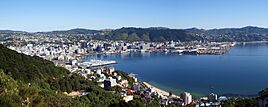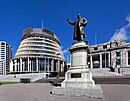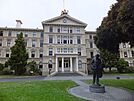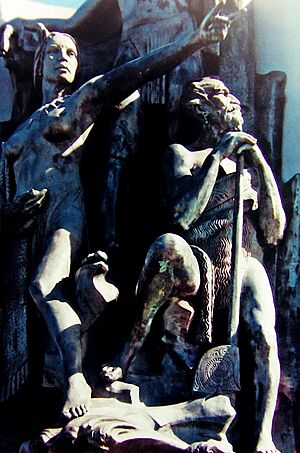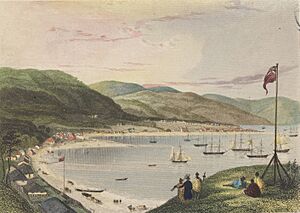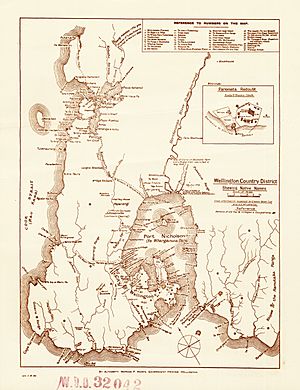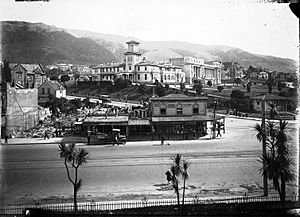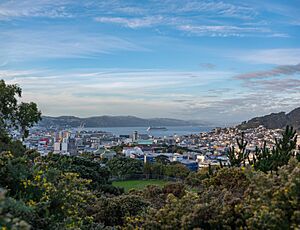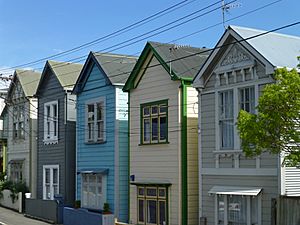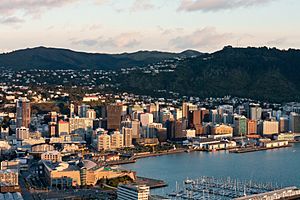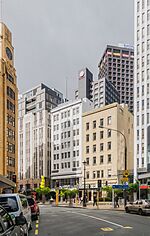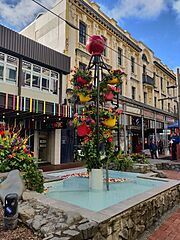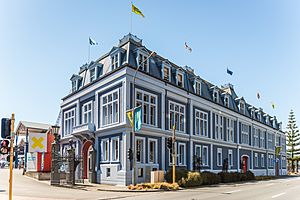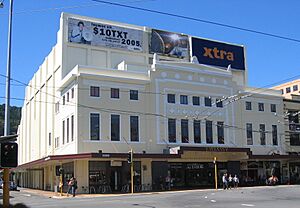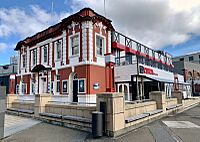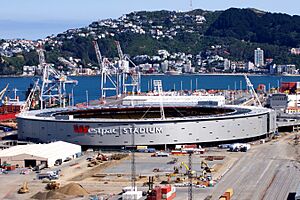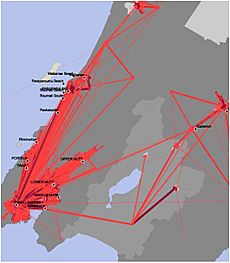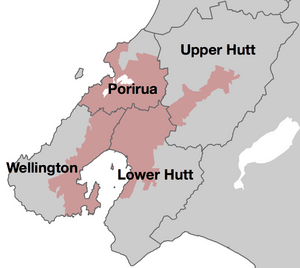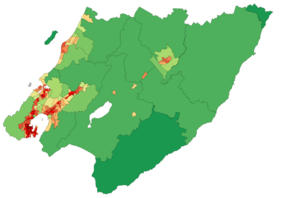Wellington facts for kids
Quick facts for kids
Wellington
Te Whanganui-a-Tara (Māori)
|
|||
|---|---|---|---|
|
Capital city
|
|||
|
Wellington Central and Lambton Harbour
National War Memorial, Dominion Museum, Government House
|
|||
|
|||
| Nickname(s):
Windy Wellington, Wellywood
|
|||
| Motto(s): | |||
| Country | New Zealand | ||
| Region | Wellington | ||
| Wards |
|
||
| Community boards |
|
||
| Settled by Europeans | 1839 | ||
| Named for | Arthur Wellesley, 1st Duke of Wellington | ||
| Electorates | Mana Ōhāriu Rongotai Te Tai Hauāuru (Māori) Te Tai Tonga (Māori) Wellington Central |
||
| Area | |||
| • Territorial | 289.91 km2 (111.93 sq mi) | ||
| • Urban | 112.71 km2 (43.52 sq mi) | ||
| • Rural | 177.20 km2 (68.42 sq mi) | ||
| • Metro | 303.00 km2 (116.99 sq mi) | ||
| Highest elevation | 495 m (1,624 ft) | ||
| Lowest elevation | 0 m (0 ft) | ||
| Population
(June 2023)
|
|||
| • Urban | 215,200 | ||
| • Urban density | 1,909.3/km2 (4,945.1/sq mi) | ||
| • Metro | 440,900 | ||
| • Metro density | 1,455.12/km2 (3,768.7/sq mi) | ||
| • Demonym | Wellingtonian | ||
| GDP | |||
| • Metro | NZ$47,465 billion (2023) |
||
| • Per capita | NZ$86,805 (2023) |
||
| Time zone | UTC+12 (NZST) | ||
| • Summer (DST) | UTC+13 (NZDT) | ||
| Postcode(s) |
5016, 5028, 6011, 6012, 6021, 6022, 6023, 6035, 6037, 6972
|
||
| Area code(s) | 04 | ||
| Local iwi | Ngāti Toa Rangatira, Ngāti Raukawa, Te Āti Awa | ||
| Website | |||
Wellington is the capital city of New Zealand. It is found at the very bottom of the North Island. The city sits between Cook Strait and the Remutaka Range. Wellington is the third-largest city in New Zealand. It is also the second-largest city on the North Island. Wellington is the administrative center for the Wellington Region. It is the world's southernmost capital city of a country. Wellington has a mild ocean climate. It is known as the world's windiest city because of its average wind speed.
Māori stories say that Kupe discovered and explored this area around the 10th century. The first people to live here were Māori iwi (tribes) like Rangitāne and Muaūpoko. Later, in the early 1800s, northern iwi like Te Āti Awa took over the area during the Musket Wars.
Wellington was designed in 1840 by Captain William Mein Smith. He was the first Surveyor General for Edward Wakefield's New Zealand Company. Smith's plan included a series of connected street layouts. These spread out along valleys and lower hills. The urban area of Wellington has about 215,200 people. The larger metropolitan area includes Lower Hutt, Porirua, and Upper Hutt. This area has a population of about 440,900 people. Wellington has been New Zealand's capital since 1865. This status is based on tradition, not a law. The New Zealand Government, Parliament, and Supreme Court are all in Wellington.
Wellington's economy mainly focuses on services. This includes finance, business, government, and the film industry. It is a major center for New Zealand's film and special effects. It is also growing as a hub for information technology. The city has two public research universities. Wellington is one of New Zealand's main seaports. It handles both local and international shipping. Wellington International Airport is the country's third-busiest airport. Wellington's transport network includes train and bus lines. These reach the Kāpiti Coast and Wairarapa. Ferries connect the city to the South Island.
Wellington is often called New Zealand's cultural capital. Its culture is diverse and often led by young people. It has influenced many places across Oceania. In 2021, Wellington was tied with Tokyo as the fourth most liveable city in the world. From 2017 to 2018, Deutsche Bank ranked it first for liveability and low pollution. Areas like Cuba Street and Newtown are known for creativity. They have unique shops, historic buildings, and great food. Wellington is also a leading financial centre in the Asia-Pacific region. It was ranked 46th globally in 2024. The city has grown from a busy Māori settlement to a modern capital. It has seen a "remarkable creative resurgence."
Contents
- What's in a Name?
- Wellington's Past: A Journey Through Time
- Exploring Wellington's Geography
- People and Culture in Wellington
- Wellington's Buildings: A Look at its Architecture
- Homes and Living in Wellington
- Wellington's Economy: How the City Works
- Arts and Culture: Wellington's Creative Heart
- Food and Drink: Wellington's Cuisine
- Sports Teams in Wellington
- Learning in Wellington: Education
- Getting Around Wellington: Transport
- Wellington's Infrastructure: How the City Works
- Media in Wellington
- Wellington's Sister Cities
- Wellington's Wider Area: The Metropolitan Region
- See also
What's in a Name?
Wellington is named after Arthur Wellesley, 1st Duke of Wellington. He was the first Duke of Wellington. He won the Battle of Waterloo in 1815. His title comes from the town of Wellington in England. The first settlers of the New Zealand Company named the city in November 1840. They did this to thank the Duke for supporting their plans to settle New Zealand.
In the Māori language, Wellington has three names:
- Te Whanganui-a-Tara means "the great harbour of Tara." This name refers to Wellington Harbour. The main settlement of Wellington is said to have been started by Tara. He was the son of Whatonga, a chief from the Māhia Peninsula.
- Pōneke is thought to be a Māori version of "Port Nick." This is short for "Port Nicholson." Another idea is that Pōneke comes from Pō Nekeneke. This means "journey into the night." It refers to the Te Āti Awa people leaving the area.
- Te Upoko-o-te-Ika-a-Māui means "The Head of the Fish of Māui." This is a traditional name for the southern part of the North Island. It comes from the legend of the demigod Māui fishing up the island.
The famous Māori explorer Kupe is said to have visited the harbour before 1000 CE. He supposedly named the two islands in the harbour after his daughters. These are Matiu (Somes Island) and Mākaro (Ward Island).
In New Zealand Sign Language, the name is signed by making a "W" shape with your fingers. You then shake it slightly from side to side.
The city is close to the narrow Cook Strait. This makes it very windy. This is why it is often called "Windy Wellington."
Wellington's Past: A Journey Through Time
Early Māori Life in Wellington
Stories say that Kupe discovered and explored the Wellington area around the 10th century. Before Europeans arrived, Māori people lived here seasonally. We have strong evidence that people lived in New Zealand by about 1280.
Different Māori groups have lived in Wellington since the 12th century. The explorer Kupe is said to have stayed in the harbour around 925 CE. A later explorer, Whatonga, named the harbour Te Whanganui-a-Tara after his son Tara. Before the 1820s, most people in the Wellington region were descendants of Whatonga.
Around 1820, the people living there were Ngāti Ira and other groups. However, these groups were later forced out by other iwi (Māori tribes) from the north. These new groups included Ngāti Toa, Te Ātiawa, and others.
How Europeans Settled Wellington
European settlement began in 1839. Colonel William Wakefield came to buy land for the New Zealand Company. He wanted to sell it to British settlers. Before this, Māori people had already met European whalers and traders.
The first European settlers arrived on the ship Tory in September 1839. Then, 150 more settlers came on the Aurora in January 1840. So, Wellington was settled before the Treaty of Waitangi was signed in February 1840. The 1840 settlers first built homes at Petone. This area was swampy and flooded often. Most newcomers then moved their settlement across Wellington Harbour to Thorndon. This is where Wellington city is today.
Wellington Becomes the Capital
Wellington was made a city in 1840. It was chosen as New Zealand's capital city in 1865.
Wellington replaced Auckland as the capital. Auckland had been the capital since 1841. The New Zealand Parliament first met in Wellington temporarily in 1862. In 1863, the Prime Minister of New Zealand, Alfred Domett, suggested moving the capital. He said it should be in the Cook Strait region. People worried that the South Island, which had goldfields, might form its own colony. Neutral experts from Australia said Wellington was a good choice. They noted its central location and excellent harbour. It was believed the entire Royal Navy fleet could fit into the harbour. Wellington's capital status is based on tradition, not a specific law.
Wellington is New Zealand's political center. It houses the country's main government buildings. The New Zealand Parliament moved to Wellington in 1865. The first official session of parliament in the new capital was on 26 July 1865. At that time, Wellington's population was only 4,900.
The Government Buildings were built in 1876. They housed government departments. The capital city also has the highest court, the Supreme Court of New Zealand. Government House, where the Governor-General lives, is in Newtown. Premier House, the Prime Minister's official home, is in Thorndon.
In 1939 and 1940, Wellington hosted the New Zealand Centennial Exhibition. This celebrated 100 years since the Treaty of Waitangi was signed. The exhibition attracted over 2.5 million visitors. At that time, New Zealand's population was 1.6 million.
Exploring Wellington's Geography
Wellington is at the southwestern tip of the North Island. It is on Cook Strait, which separates the North and South Islands. On a clear day, you can see the snow-capped Kaikōura Ranges across the strait. To the north are the golden beaches of the Kāpiti Coast. To the east, the Remutaka Range separates Wellington from the Wairarapa plains. The Wairarapa is a famous wine region.
With a latitude of 41° 17' South, Wellington is the southernmost capital city in the world. Wellington is also one of the most remote capital cities. It is 2,326 km (1,445 mi) from Canberra, Australia.
Wellington is more crowded than most New Zealand cities. This is because there isn't much flat land between its harbour and hills. It has few open areas to grow. This has led to the growth of suburban towns. Wellington is the world's windiest city. This is due to its location in the Roaring Forties and strong winds from Cook Strait. The average wind speed is 27 km/h (17 mph).
Wellington's beautiful natural harbour and green hillsides are popular with tourists. The city center is near Lambton Harbour. This part of Wellington Harbour sits along an active geological fault. The land to the west rises steeply. This means many suburbs are high above the city center. There are many walking tracks and nature reserves. These are cared for by the Wellington City Council. Otari-Wilton's Bush is one such reserve. It protects native plants. The Wellington region has 500 square kilometres (190 sq mi) of regional parks and forests.
The narrow entrance to the harbour is east of the Miramar Peninsula. It has dangerous shallow areas called Barrett Reef. Many ships have been wrecked here. The harbour has three islands: Matiu/Somes Island, Makaro/Ward Island, and Mokopuna Island. Only Matiu/Somes Island is large enough for people to live on. It has been used as a quarantine station and a camp during wars. Now, it is a conservation island. It protects endangered species.
Earthquakes and Wellington's Landscape
Wellington has been badly damaged by earthquakes. Major quakes happened in 1848 and 1855. The 1855 Wairarapa earthquake was likely the strongest in New Zealand's recorded history. It caused the land to rise by two to three meters. This created new land from the harbour. Much of this land was later filled in. It is now part of the city center. This is why Lambton Quay street is 100 to 200 meters from the harbour today. Plaques on the footpath show where the shoreline was in 1840.
The area has high seismic activity. A major fault, the Wellington Fault, runs through the city. Several hundred smaller faults are also in the urban area. People often feel several earthquakes each year. For many years after the 1855 earthquake, most buildings were made of wood. The Government Buildings near Parliament are the largest wooden building in the Southern Hemisphere. Building rules became stricter in the 20th century. After the 2010 and 2011 earthquakes, earthquake readiness became even more important. Some newer buildings have been demolished rather than rebuilt.
A slow earthquake happens under Wellington every five years. It stretches from Kapiti to the Marlborough Sounds. It releases as much energy as a magnitude 7 quake. But because it happens slowly, it causes no damage.
In 2013, there were many earthquakes in Cook Strait. The 6.5 magnitude 2013 Seddon earthquake hit on 21 July. The 6.6 magnitude 2013 Lake Grassmere earthquake struck on 16 August. Neither caused major damage. In January 2014, a 6.2 magnitude earthquake struck near Eketāhuna. It caused little damage in Wellington. One large eagle sculpture at Wellington Airport fell from the ceiling.
On 14 November 2016, the 7.8 magnitude 2016 Kaikōura earthquake caused significant damage. It was centered in the South Island. Wellington's city center, Victoria University of Wellington, and the rail network were closed for inspections. Many buildings were damaged. Some newer buildings, like the NZDF headquarters, were demolished.
Wellington's Hills and Views
Wellington city is shaped by its steep hills. These hills limit how much the city can expand. Notable hills in and around Wellington include:
- Mount Victoria (196 m): A popular spot for walks. From the top, you can see most of Wellington. It has many mountain bike and walking tracks.
- Mount Kaukau (445 m): This is where Wellington's main television transmitter is located.
- Mākara Peak: Its summit (412 m) is part of a 250-hectare mountain bike park. This park has 45 km of trails.
- Te Ahumairangi (Tinakori) Hill
Wellington's Weather: Windy and Mild
Wellington gets about 2,055 hours of sunshine each year. Its climate is generally mild all year round. Summers are gentle, and winters are cool to mild. Temperatures rarely go above 26 °C (79 °F) or below 4 °C (39 °F). The hottest temperature ever recorded was 31.1 °C (88 °F) in 1896. The coldest was −1.9 °C (29 °F). The city is famous for its strong southerly winds in winter. These winds can make it feel much colder. It is generally very windy all year. It also gets a lot of rain, with an average of 1,250 mm (49 in) per year. June and July are the wettest months.
Frosts are common in the hill suburbs and the Hutt Valley from May to September. Snow is very rare at low parts of the city. However, snow did fall on the city in July and August 2011. Snow at higher altitudes is more common. Light snow falls in higher suburbs every few years.
On 29 January 2019, the suburb of Kelburn reached 30.3 °C (87 °F). This was the highest temperature since records began in 1927.
People and Culture in Wellington
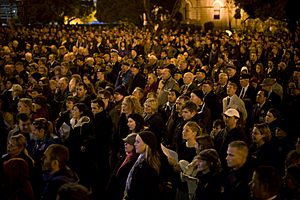
Wellington City covers 289.91 km2 (111.93 sq mi). It had about 216,200 people in 2023. The population density is about 746 people per km2. This includes people in the urban area and surrounding rural areas.
In the 2023 census, Wellington City had 202,689 people. This was a small decrease from 2018. The median age was 34.9 years. About 14.4% of people were under 15 years old. About 27.2% were aged 15 to 29.
Most people (72.1%) identified as European. Other groups included Māori (9.8%), Asian (20.4%), and Pasifika (5.7%). English was spoken by 96.3% of people. The percentage of people born overseas was 34.4%.
About 57.7% of people said they had no religion. Of those aged 15 or older, 36.0% had a university degree or higher. The median income was $55,500. This is higher than the national average. About 59.0% of people were employed full-time.
Living Well in Wellington
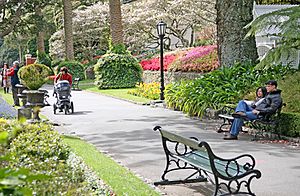
Wellington ranks high for quality of living. A 2023 study by Mercer placed it 12th in the world. In the Asia–Pacific region, it was third, after Auckland and Sydney.
In 2024, Wellington was seen as an affordable city for living costs. It ranked 145th out of 226 cities in a worldwide survey.
Wellington's Rich Culture and Identity
Wellington has many of New Zealand's largest and oldest cultural institutions. These include the National Archives and the National Library. It also has Te Papa, New Zealand's national museum. Many theaters are here too. It is home to the New Zealand Symphony Orchestra and Royal New Zealand Ballet.
Its buildings are also cultural attractions. The Old Government Buildings are one of the largest wooden buildings in the world. The Beehive is the executive wing of Parliament. The Futuna Chapel is a famous building designed by Māori architect John Scott. The city has many art galleries. These include the national art collection at Toi Art at Te Papa. Wellington also hosts many events. These include CubaDupa, Wellington On a Plate, and the Newtown Festival.

Wellington's Buildings: A Look at its Architecture

Wellington shows off many building styles from the last 150 years. You can see 19th-century wooden cottages. An example is the Italianate Katherine Mansfield Birthplace. There are also sleek Art Deco buildings. These include the old Wellington Free Ambulance headquarters. Post-modern buildings with curves and bright colors are in the city center.
The oldest building is the 1858 Nairn Street Cottage. The tallest building is the Majestic Centre at 116 meters high. The Futuna Chapel in Karori is a very important New Zealand building. It was designed by Māori architect John Scott. Old St Paul's is a beautiful 19th-century church. It shows how Gothic Revival style was adapted for colonial times. Sacred Heart Cathedral is a grand Palladian Revival building.
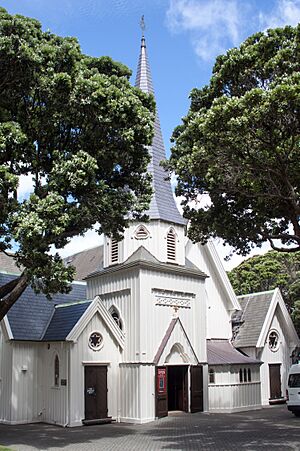
Te Ngākau Civic Square is a central public space. It is surrounded by the Wellington Town Hall and council offices. It also has the Michael Fowler Centre and the Wellington Central Library.
As the capital, Wellington has many important government buildings. The Executive Wing of New Zealand Parliament Buildings is known as the Beehive. Across the road is the Old Government Buildings. This is the largest wooden building in the Southern Hemisphere. It now houses part of Victoria University of Wellington's Law Faculty.

A modern building on the waterfront houses the Museum of New Zealand Te Papa Tongarewa. It is built with special earthquake protection. This system helps the building move slowly during an earthquake.
Other notable buildings include Wellington Town Hall and Wellington railway station. Wellington has many famous sculptures. These include the Bucket Fountain in Cuba Street. The Zephyrometer is a 26-meter orange spike that moves with the wind.
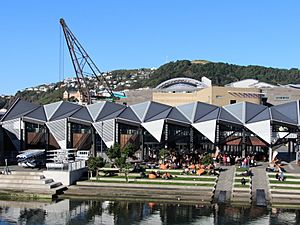
Wellington has many different architectural styles. You can see classic Painted Ladies in Mount Victoria. There are also wooden Art Deco houses. The city center has large modern buildings like the Majestic Centre.
Homes and Living in Wellington
House Prices in Wellington
Wellington's housing market saw a big increase in prices in the early 2000s. Then, prices dropped in 2007. By 2008, property values had gone down by about 9.3%. More expensive homes dropped even more, sometimes by 20%.
Since 2009, house prices in Wellington have gone up a lot. In May 2021, the median house price in Wellington City was $1,057,000. This made it hard for first-time buyers. House prices reached their highest point in February 2022. By December 2023, they had fallen by 25%.
The high cost of housing makes it difficult for some workers, like nurses, to live in Wellington. The median rent in Wellington has also increased a lot. It is now $600 per week, which is even higher than Auckland.
Quality of Homes
Despite the high cost, the quality of housing in Wellington has been criticized. About 18.4% of houses in Wellington City are sometimes or always moldy. Also, 24% are sometimes or always damp. Both of these figures are higher than the average for New Zealand.
A survey in 2009 looked at people living in city center apartments. Most were New Zealanders aged 24 to 35 with professional jobs. Their household income was higher than in surrounding areas. Most (73%) walked to work or university. The main reasons for living in an apartment were lifestyle (23%) and being close to work (20%). The main downsides were city noise (27%) and a lack of outdoor space (17%).
Wellington's Economy: How the City Works
Wellington Harbour is one of New Zealand's main seaports. It handles about 10.5 million tonnes of cargo each year. It imports things like petroleum and cars. It exports meats, wood, and dairy products. Many cruise ships also visit the port.
The government sector has always been a key part of Wellington's economy. Its central location meant many company head offices were here. This included finance, technology, and heavy industry. However, many have moved to Auckland over time.
Recently, tourism, arts, culture, film, and ICT have become more important. Wellington's average income is higher than the New Zealand average. It has the highest income among all New Zealand cities. Many people in Wellington have university degrees.
Tourism in Wellington
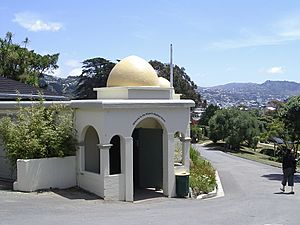
Tourism is a big part of Wellington's economy. It brings in about NZ$1.3 billion each year. It also accounts for 9% of all full-time jobs. The city is often named New Zealanders' favorite place to visit. Lonely Planet ranked it fourth in the world for cities to visit in 2011.
New Zealanders are the biggest group of visitors. They make 3.6 million visits each year. International visitors spend NZ$436 million annually. Australia is the largest international visitor market.
The Te Papa museum helped turn Wellington into a popular tourist spot. Wellington is marketed as the 'coolest little capital in the world'. This is done by Positively Wellington Tourism.
Popular tourist attractions include Wellington Museum, Wellington Zoo, Zealandia, and the Wellington Cable Car. Cruise tourism is growing fast. The 2010/11 season saw 125,000 passengers.
Wellington is also a popular place for conferences. This is because it is compact and has many cultural attractions. In the year ending March 2011, there were almost 800,000 conference visitor days. This brought in about NZ$100 million to the economy.
Arts and Culture: Wellington's Creative Heart
Wellington's Unique Culture
Wellington is known as "the coolest little capital." It is also called New Zealand's "cultural and creative capital." The city is famous for its coffee scene. Many globally popular foods and drinks, like the flat white, were perfected here. Wellington has more cafés per person than New York City. This coffee culture was started by Italian and Greek immigrants.
Wellington's culture is vibrant and diverse. It is New Zealand's second most ethnically diverse city, after Auckland. It has a "melting pot" of cultures. This includes people from Malaysia, Italy, the Netherlands, Korea, China, Greece, India, and Samoa. Wellington is known for its art, food, and international filmmaking. Films like Avatar and The Lord of the Rings were largely made here. The World of Wearable Arts (WOW) is a yearly event that attracts many visitors.
Museums and Cultural Places

Wellington is home to many cultural institutions. These include Te Papa (the Museum of New Zealand). Also here are the National Library of New Zealand and Archives New Zealand. Other places are Wellington Museum, the Katherine Mansfield House and Garden, and the Wellington Cable Car Museum.
Festivals and Events
Wellington hosts many big events and cultural celebrations. These include the New Zealand Festival of the Arts and the Wellington Jazz Festival. There's also the Capital E National Arts Festival for Children. Major events include World of Wearable Art and Cuba Street Carnival. Other popular events are Wellington On a Plate and the New Zealand Fringe Festival.
The yearly children's Artsplash Festival brings together hundreds of students. It features music, dance, and visual arts. The Performance Arcade is an annual live-art event on the waterfront.
Wellington and Film: Wellywood
Filmmakers Sir Peter Jackson and Sir Richard Taylor have made the suburb of Miramar a film hub. It is now a center for filmmaking, post-production, and special effects. This has led to the nickname 'Wellywood'. Jackson's companies include Wētā Workshop and Wētā FX. Films partly or fully shot in Wellington include the Lord of The Rings trilogy and King Kong.
Wellington has many independent cinemas. These include the Embassy Theatre and the Roxy. They participate in film festivals all year. Wellington has one of the highest turnouts for the annual New Zealand International Film Festival.
Music Scene
Wellington's music scene has produced many famous bands. These include The Phoenix Foundation, Shihad, and Fat Freddy's Drop. The New Zealand School of Music was created in 2005. It combined music programs from Massey University and Victoria University of Wellington. The New Zealand Symphony Orchestra is also based in Wellington.
Theatre and Dance
Wellington is home to BATS Theatre and Circa Theatre. It also has the national Māori theatre company Taki Rua. The Royal New Zealand Ballet is based here too.
The main venues include St James' Theatre and The Opera House.
Comedy in the Capital
Many famous New Zealand comedians started in Wellington. These include Ginette McDonald and Flight of the Conchords.
Wellington has groups that perform improvised theater. The city also hosts shows for the annual New Zealand International Comedy Festival.
Visual Arts
From 1936 to 1992, Wellington was home to the National Art Gallery of New Zealand. Now, it is part of Museum of New Zealand Te Papa Tongarewa. Wellington also has the New Zealand Academy of Fine Arts. The city's arts centre, Toi Pōneke, is a hub for creative projects. Other art galleries include the City Gallery.
- Te Ngākau Civic Square with the ''Ferns'' artwork suspended above
Food and Drink: Wellington's Cuisine
Wellington is known for its many small restaurants. Its café culture is famous worldwide. The city has more cafés per person than New York City. Some iconic cafés started Wellington's coffee obsession.
Wellington restaurants offer food from Europe, Asia, and Polynesia. For a true New Zealand style, you can find lamb, pork, and venison. Seafood like salmon, crayfish, and Bluff oysters are popular. Local shellfish like pāua, mussels, and scallops are also common. Sweet potato (kūmara), kiwifruit, and tamarillo are local produce. And don't forget pavlova, the national dessert.
Sports Teams in Wellington
Wellington is home to several sports teams:
- Hurricanes: A Super Rugby team.
- Wellington Lions: An ITM Cup rugby team.
- Wellington Phoenix FC: A football (soccer) club that plays in the Australasian A-League. It is New Zealand's only fully professional football club.
- Team Wellington: Plays in the semi-professional New Zealand Football Championship.
- Central Pulse: A netball team representing the Lower North Island.
- Wellington Firebirds and Wellington Blaze: Men's and women's cricket teams.
- Wellington Saints: A basketball team in the National Basketball League.
Learning in Wellington: Education
Wellington offers many college and university programs:
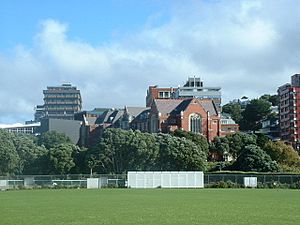
Victoria University of Wellington has four campuses. It uses a three-trimester system. In 2008, it had 21,380 students. Most students were New Zealanders of European descent. It also had many Māori, Pacific, and international students.
Massey University has a Wellington campus. It is known as the "creative campus." It offers courses in communication, business, engineering, and arts. Its design school started in 1886.
The University of Otago has a Wellington branch. It includes the Wellington School of Medicine and Health.
Whitireia New Zealand has campuses in Porirua, Wellington, and Kapiti. The Wellington Institute of Technology and New Zealand's National Drama school, Toi Whakaari, are also here. The Wellington area has many primary and secondary schools.
Getting Around Wellington: Transport
Wellington is served by State Highway 1 and State Highway 2. These meet north of the city center. Road access into the capital is limited by mountains.
Buses in Wellington are run by different operators under the Metlink brand. Buses serve almost all parts of Wellington city. Most run along the "Golden Mile" from Wellington railway station to Courtenay Place. Until 2017, Wellington had trolleybus routes. This was the last public trolleybus system in the Southern Hemisphere.
Wellington is at the southern end of the North Island Main Trunk railway. Two long-distance train services leave from Wellington. The Capital Connection is for commuters from Palmerston North. The Northern Explorer goes to Auckland.

Four electrified suburban train lines go from Wellington railway station. These lines serve suburbs to the north. A diesel train service, the Wairarapa Connection, connects to Masterton. These services carry 11.64 million passengers each year.
CentrePort Wellington manages the port of Wellington. It provides services for shipping and cargo. It also handles the Cook Strait ferries to Picton. These ferries are run by Interislander and Bluebridge. Local ferries connect Wellington city center with Eastbourne and Seatoun.
Wellington International Airport is 6 kilometres (3.7 mi) southeast of the city center. It has flights from New Zealand, Australia, Singapore, and Fiji. Flights to other international places need a transfer. This is because Wellington's runway is short (2,081-metre or 6,827-foot).
Wellington's Infrastructure: How the City Works
Electric Power
Wellington's first public electricity supply started in 1904. This was when electric trams were introduced. Today, Wellington city gets power from four Transpower substations. Wellington Electricity manages the local power network.
The city has two large wind farms. West Wind and Mill Creek provide up to 213 MW of electricity. Wellington has a very reliable power supply. In 2018, customers spent only 55 minutes without power due to unplanned outages.
Natural Gas
Wellington was one of the first New Zealand cities to get natural gas. This happened in 1970. A long pipeline from the Kapuni gas field in Taranaki was built. The main gas pipelines are now owned by First Gas. Powerco manages the local gas distribution.
Water Services
The "three waters" – drinking water, stormwater, and wastewater – are managed by Wellington Water. This company handles water assets for Wellington City and nearby councils.
Wellington's first piped water supply came from a spring in 1867. Today, Greater Wellington Regional Council supplies water to Wellington and nearby cities. The water comes from rivers like Wainuiomata River and Hutt River.
There are four wastewater treatment stations in the Wellington area. These are at Moa Point, Seaview, Karori, and Porirua. Wellington faces challenges with old water infrastructure. There have been some major failures. The water supply is also at risk during a major earthquake. Many projects are planned to make the water supply more resilient.
In May 2021, the Wellington City Council approved a plan to spend $2.7 billion on water pipe maintenance. They also planned to spend $147 to $208 million on plant upgrades. In November 2023, Wellington Water said that $1 billion per year is needed to fix water issues.
Media in Wellington
Newspapers
For many years, Wellington had two daily newspapers. The Evening Post was an afternoon paper. The Dominion was a morning paper. The two newspapers merged in 2002 to form The Dominion Post. In April 2023, it was renamed The Post.
Radio
Wellington has 26 full-power radio stations. These include stations on FM and AM.
Television
Television broadcasts started in Wellington on 1 July 1961. This was with channel WNTV1. WNTV1's main studios were in central Wellington. They broadcast from a transmitter on Mount Victoria. In 1967, a more powerful transmitter was built on Mount Kaukau. In 1969, WNTV1 joined with other stations to form NZBC TV.
In 1975, NZBC was split up. Wellington studios became Television One. The studios moved to the new Avalon Television Centre in Lower Hutt. In 1980, Television One and Two merged to form Television New Zealand (TVNZ). Most TV production moved to Auckland in the 1980s.
Today, digital television (Freeview) is available. It broadcasts from Mount Kaukau.
Wellington's Sister Cities
Wellington has special relationships with other cities around the world. These are called "sister city" relationships:
- Sydney, Australia (since 1983)
- Xiamen, China (since 1987)
- Sakai, Japan (since 1994)
- Beijing, China (since 2006)
- Canberra, Australia (since 2016)
Wellington is also a "friendly city" with Ramallah, Palestine. They are expected to become sister cities in the future. Wellington also has historical ties with Chania, Greece; Harrogate, England; and Çanakkale, Turkey.
Wellington's Wider Area: The Metropolitan Region
The larger metropolitan area of Wellington includes four local councils. These are Wellington City itself. Then there's Porirua City to the north. Porirua is known for its large Māori and Pasifika communities. Also included are Lower Hutt City and Upper Hutt City. These are mostly suburban areas to the northeast, known as the Hutt Valley.
Sometimes, places like Waikanae, Paraparaumu, and Paekākāriki on the Kāpiti Coast are included. This is because many people commute from there to Wellington.
The urban areas of the four main cities have a combined population of about 434500 residents. Most of the remaining areas are mountains or parkland. Life in Wellington is mostly focused on its city center. About 62,000 people work in the city center. This is only 4,000 fewer than in Auckland's city center, even though Auckland has four times the population.
See also
 In Spanish: Wellington para niños
In Spanish: Wellington para niños


